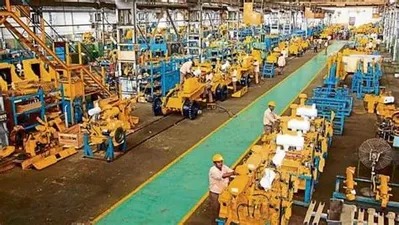
Amidst slowdown in developed countries and uncertainties over economic situation, India’s manufacturing sector posted a remarkable performance at the end of the final quarter of the fiscal (Q4 FY2022-23) with the seasonally adjusted S&P Global India Manufacturing Purchasing Managers’ Index (PMI) rose from 55.3 in February to 56.4 in March, as new orders and production levels surged to a three-month high in March, as per the S&P Global India Manufacturing Purchasing Managers’ Index (PMI) released on Monday. The seasonally adjusted PMI reading moved up from 55.3 in February to 56.4 in March, signalling the strongest improvement in operating conditions in 2023 so far. A reading of over 50 on the PMI indicates an uptick in economic activity.
Growth of factory orders and production have posted the strongest uptick in three months, with pressure on supply chains subsiding and raw material availability improving. Input cost inflation thus retreated to its second-lowest mark in two-and-a-half years, leading to a moderation in cost pressures. March data highlighted the second-weakest increase in input prices in two-and-a-half years. In fact, close to 96% of firms signalled no change in cost burdens since February.
As a consequence goods producers concentrated on rebuilding their stocks. Supporting the upturn in input stocks was a twenty-first consecutive increase in buying levels. Purchasing activity expanded at a marked pace that was the strongest since May 2022. Robust increases in buying levels in recent months supported a near-record accumulation of input inventories in March which also highlighted a further upturn in new business placed with Indian manufacturers. Moreover, the rate of expansion was sharp and the quickest in three months with firms suggesting that marketing efforts had borne fruit, the S&P report says.
Pollyanna De Lima, Economics Associate Director at S&P Global Market Intelligence notes that underlying demand for Indian goods remained strong in March, underscored by the quickest upturn in factory orders for three months. “Production continued to expand at a robust clip and firms stepped up their stockbuilding efforts. Companies reported abundant capacity among themselves and their suppliers. Pending workloads expanded only marginally in March, hindering job creation,” De Lima said.
Firms tried to benefit as much as possible from this moderation in inflation by acquiring additional raw materials and semi-finished items. This contributed to one of the strongest increases in input inventories in over 18 years of data collection. The other growth drivers were demand resilience and competitive pricing. Continuing the trend that has been recorded on a monthly basis for a year, new export orders rose in March. The rate of expansion quickened from February, though remained slight and historically subdued. Ongoing improvements in total sales volumes underpinned another increase in production. Output also rose at the quickest pace since last December and one that outpaced its long-run average. With sustained momentum in rising demand, firms were encouraged to rebuild their input inventories. Stocks of purchases rose at a sharp rate that was one of the strongest seen in over 18 years of data collection.
There was evidence of only mild pressure on the capacity of goods producers, as outstanding business volumes rose at a marginal rate that was the weakest in a year. Hence, goods producers kept payroll numbers broadly unchanged in March. This followed a one-year sequence of monthly increases in employment. Suppliers were reportedly able to deliver purchased materials in a timely manner during March, with the latest results showing a fractional improvement in vendor performance. Elsewhere, holdings of finished products decreased further. According to panellists, in some instances orders were fulfilled from warehoused items. The rate of stock depletion was only marginal, however.
Indian manufacturers expect improved customer relations, new product releases and advertising to support sales and subsequently production over the course of the coming 12 months. That said, the overall level of positive sentiment slipped to an eight-month low due to concerns surrounding competitiveness and general inflation.















